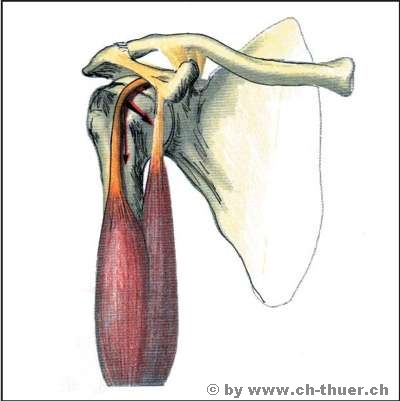|
The long and short biceps tendons emerge from the shoulder, run across the front part of the forearm in the familiar muscle belly and insert themselves jointly in the proximal (nearest the trunk) section of the forearm in a bony projection of the radius.
The primary action of the biceps is to bend the elbow. While its effect on the shoulder itself is of secondary importance, the biceps is relevant to the shoulder since the long biceps tendon originates in the upper edge of the glenoid (socket) or close to the limbus (meniscus). During rotational movements of the upper arm the long biceps tendon is guided by a complex ligamentous apparatus and tensed across the humeral head, thereby producing a centring effect on the shoulder itself, particularly when the upper arm is in a position of external rotation.
Consequently, damage to the long biceps tendon can occur if the elbow muscles are overexerted (e.g. during the infrequent, but occasionally necessary, task of snow-shovelling.) This lesion can arise close to the insertion in the limbus with attrition of the tendon, or can involve separation of the limbus with the biceps tendon attached. Such damage to the biceps tendon leads to inflammation with severe pain along the course of the tendon and radiating to the upper arm.
However, this type of overexertion of the tendon can also be caused by a sudden strain, not just by repetitive movements (e.g. when attempting to catch a falling load). Extension of the damage can lead to tearing of the tendon, causing the tendon stump to slide in a distal (downward) direction. When this happens, the patient notices, on the one hand, a reduction in the pain and, on the other, a "downward sliding" of the biceps muscle belly.
Deciding whether damage has been caused by an accident or chronic overexertion is always a very arbitrary process and always requires careful assessment on the basis of the history and clinical findings.
Any doctor working on behalf of insurers and health insurance schemes should take this task very seriously and not just make a sweeping generalisation.
|
